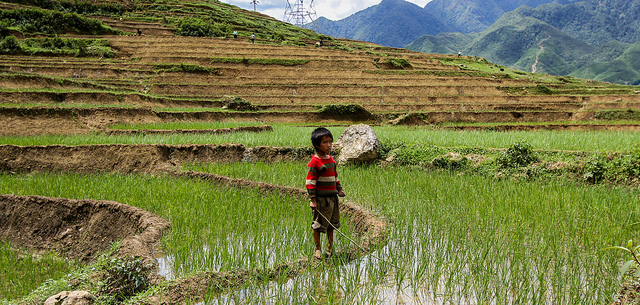
India’s Top Agricultural Crops
India is a very large country, which means the terrain, climate, and ecosystems are vast. Each region has its special characteristics when referring to agriculture, and each of these contribute to the overall economy of India. I’ll discuss the main agriculture products of India, and where they are produced. This will help people better understand the role India plays in the world scene of agriculture, and what it can most strongly contribute. These crops are also important because they supply so many jobs for people. These people rely on the crops to have a living, support themselves, and more importantly, support their families. In recent years, agriculture has increased, leading to many positive results for India and the people who occupy it.
A young boy in a rice field. The future of this field could be parallel with the boy’s. Taken by Rory Macleod.
Rice
Rice is the most abundant crop in India. It produces almost 20% of the rice for the world, which is more than any other country. The rice mainly grows in the south and the east, but may be found in other areas as well. Rice needs a very wet environment to grow successfully, and those areas are mostly found in the south and east. The heavy rains that come to those areas are very beneficial for the rice to grow efficiently. In some parts of the country, two harvests are done per year to get the most from the land, where the rest are usually just one. Rice is a staple food in India and is eaten with many different dishes.
Wheat
Another crop that India produces on a large scale is wheat. Unlike rice, wheat can grow in slightly dryer conditions, so it is found mostly in the north. In the foothills of the Himalayas lies a nice spot for wheat to thrive. Wheat is a great crop because it contributes to so many types of food. Ugali, chapati, and bread are just a few of the foods that are made with flour. These staple foods are crucial to the survival of some of the lower class people of India, as they often cook with flour.
Mangoes
Shifting now to the fruits, mangoes are found throughout the country in India. This sweet, tasty fruit has a high nutritional value and is a nice supplement to the carbohydrates listed above. Instead of growing in the ground, mangoes grow on trees, making the process slightly more difficult. There is a lot of equipment, or hands, needed for collecting the mangoes. The mangoes are grown in many areas of India rather than in specific states, as the wheat and the rice. Mangoes contribute highly to the economy because they are deported internationally for economical gains. This makes for a huge market and profit for the farmers, transporters, and consumers.
Bananas
Sticking with the fruits, bananas are also found very commonly in India. The warm tropical climate of the southern and western regions provide a natural environment for bananas to grow. Banana trees need a lot of water to thrive and produce a good crop, so frequent tending may need to be done. There are a couple different types of bananas grow in India. These consist of some that are smaller, and some larger. Each of these types has its own distinct taste, if you pay close enough attention. Bananas also supplement the diet of an Indian by containing a lot of potassium.
These crops are all important to India in it’s own way. They help to keep India strong, and increase its strength each year the crops increase in production. Having a basic understanding of this sheds awareness to a global audience. India produces many agricultural goods throughout the world, and contributes largely to meals you may be eating in your own household!

